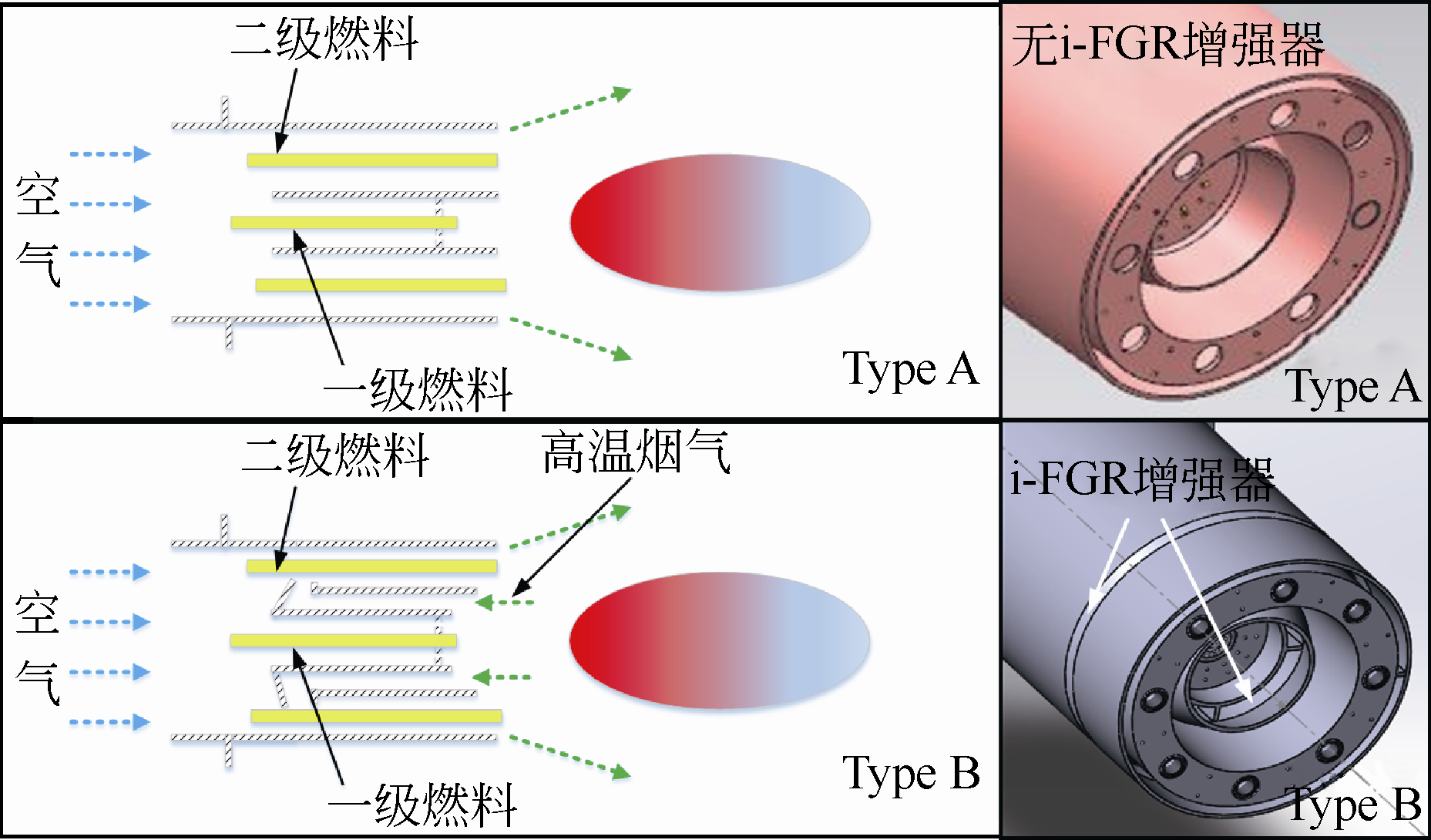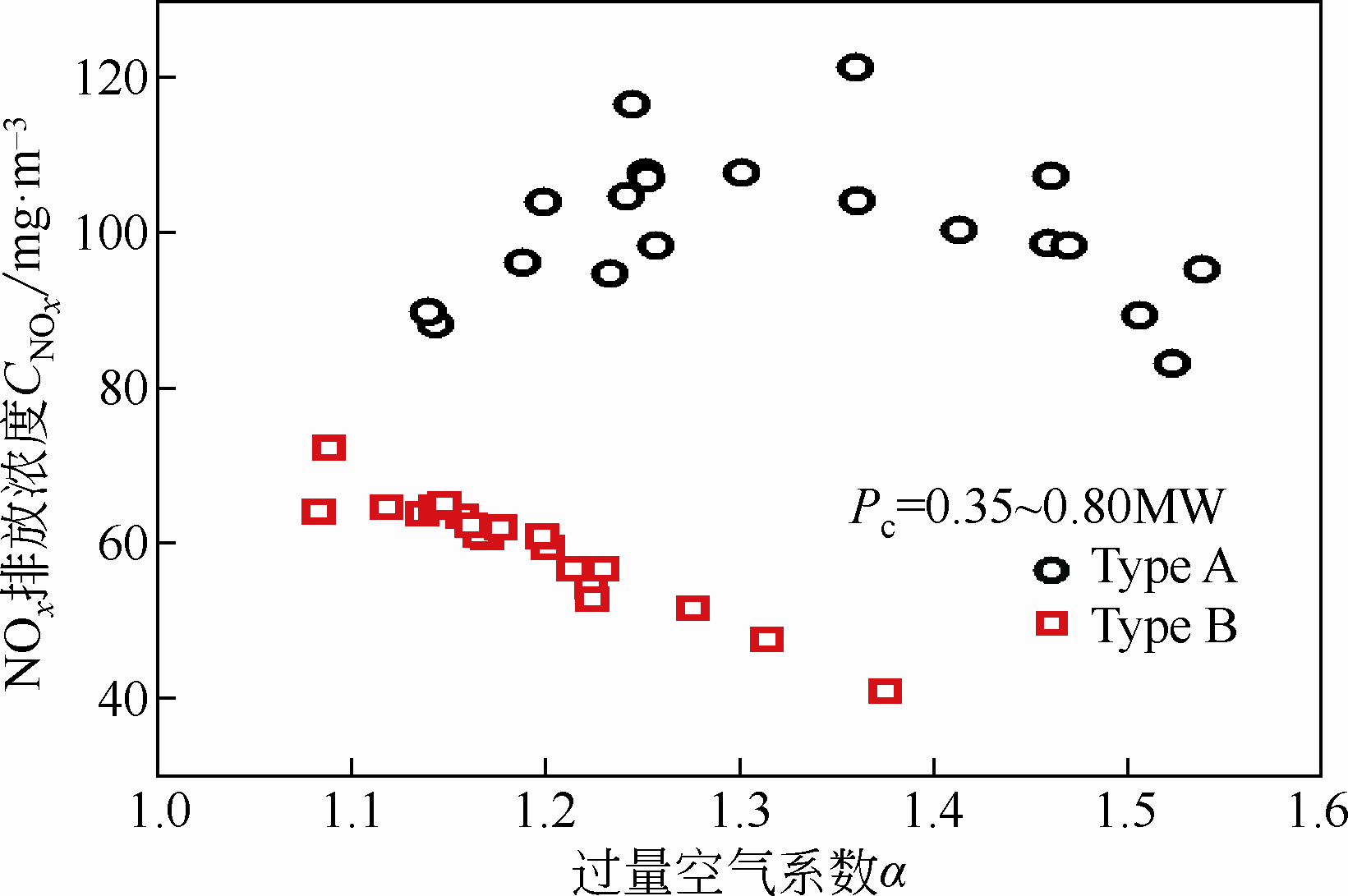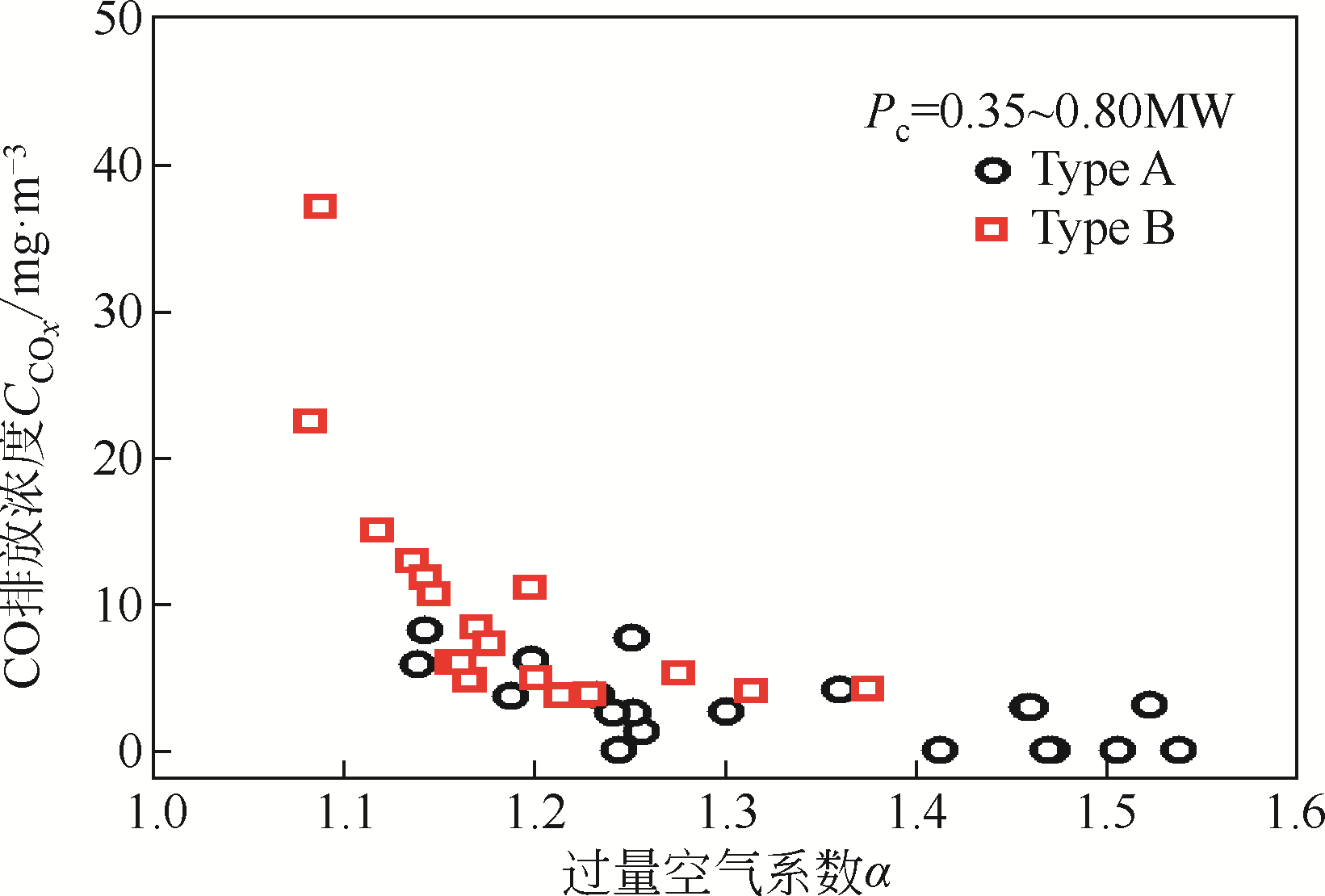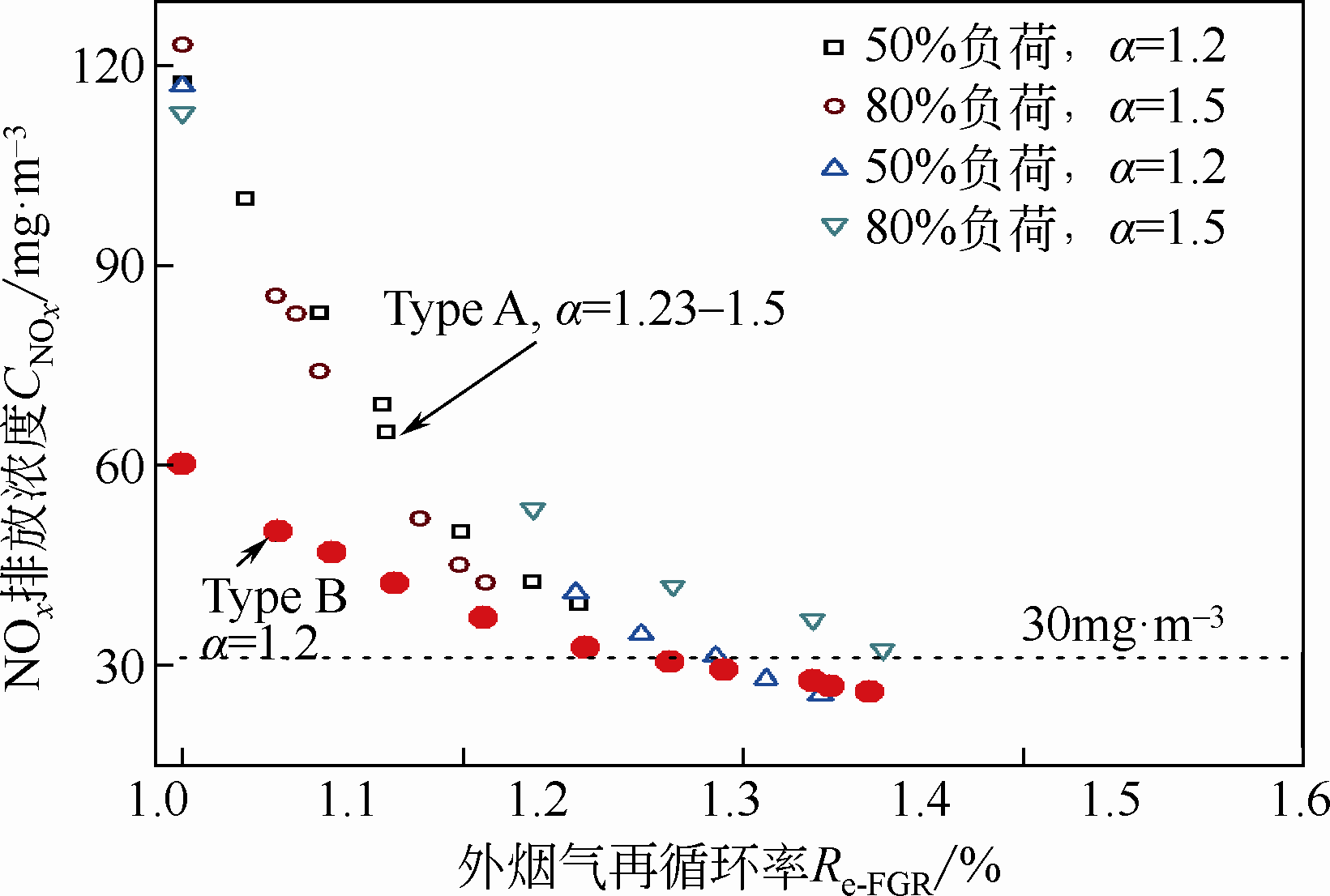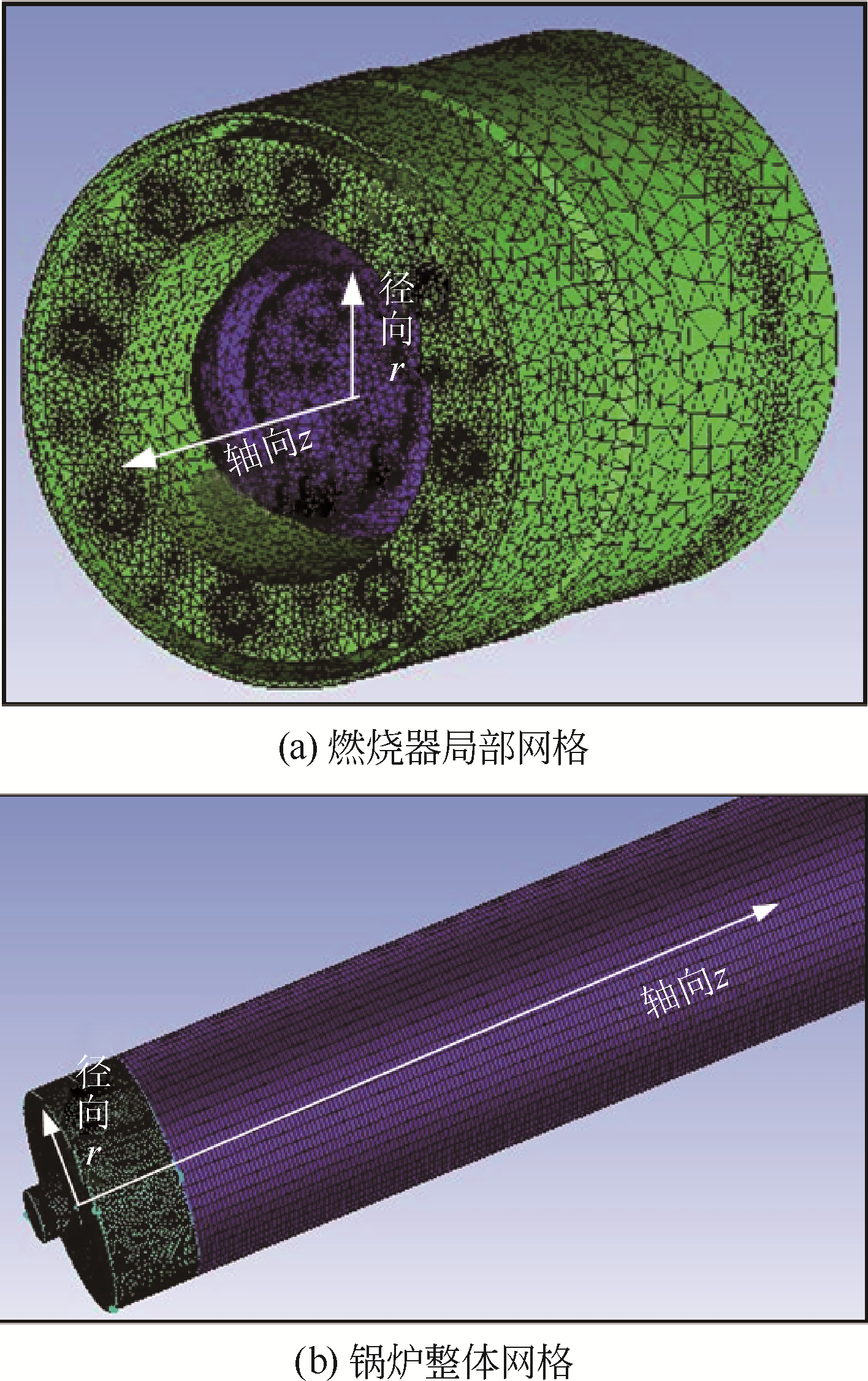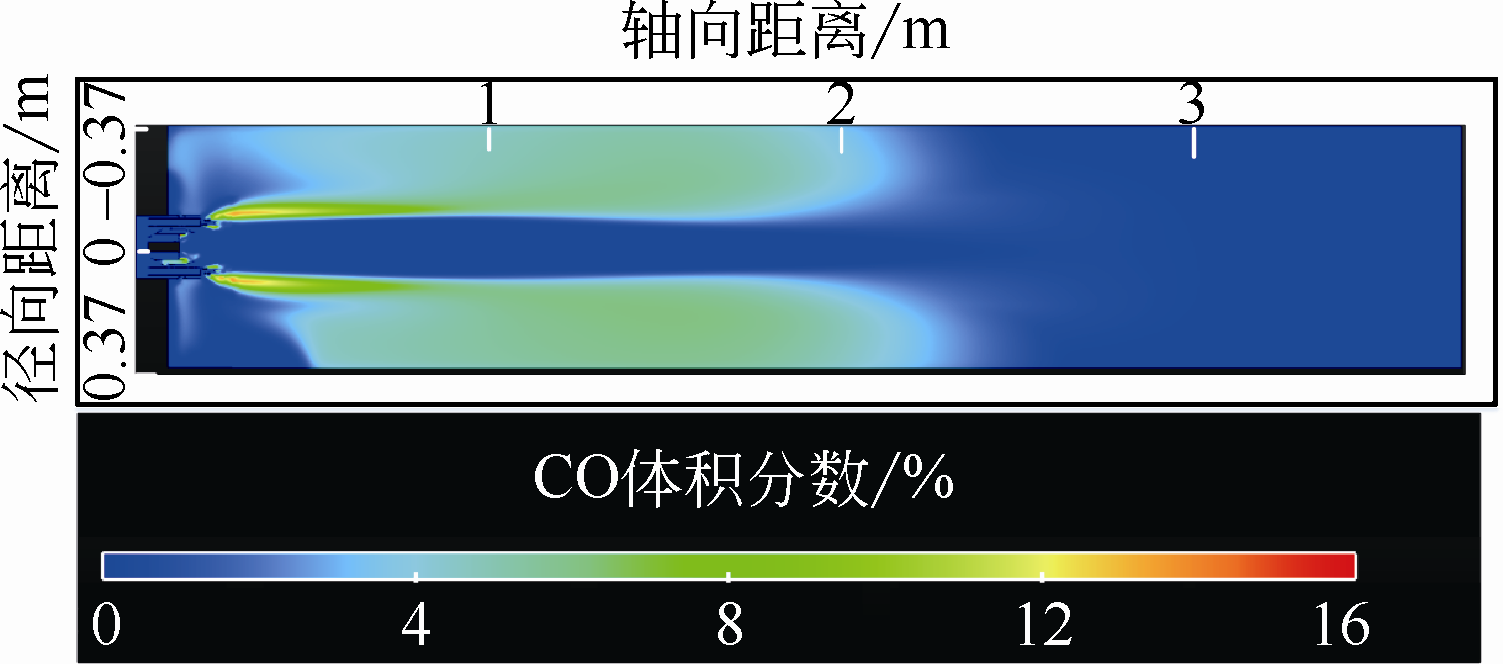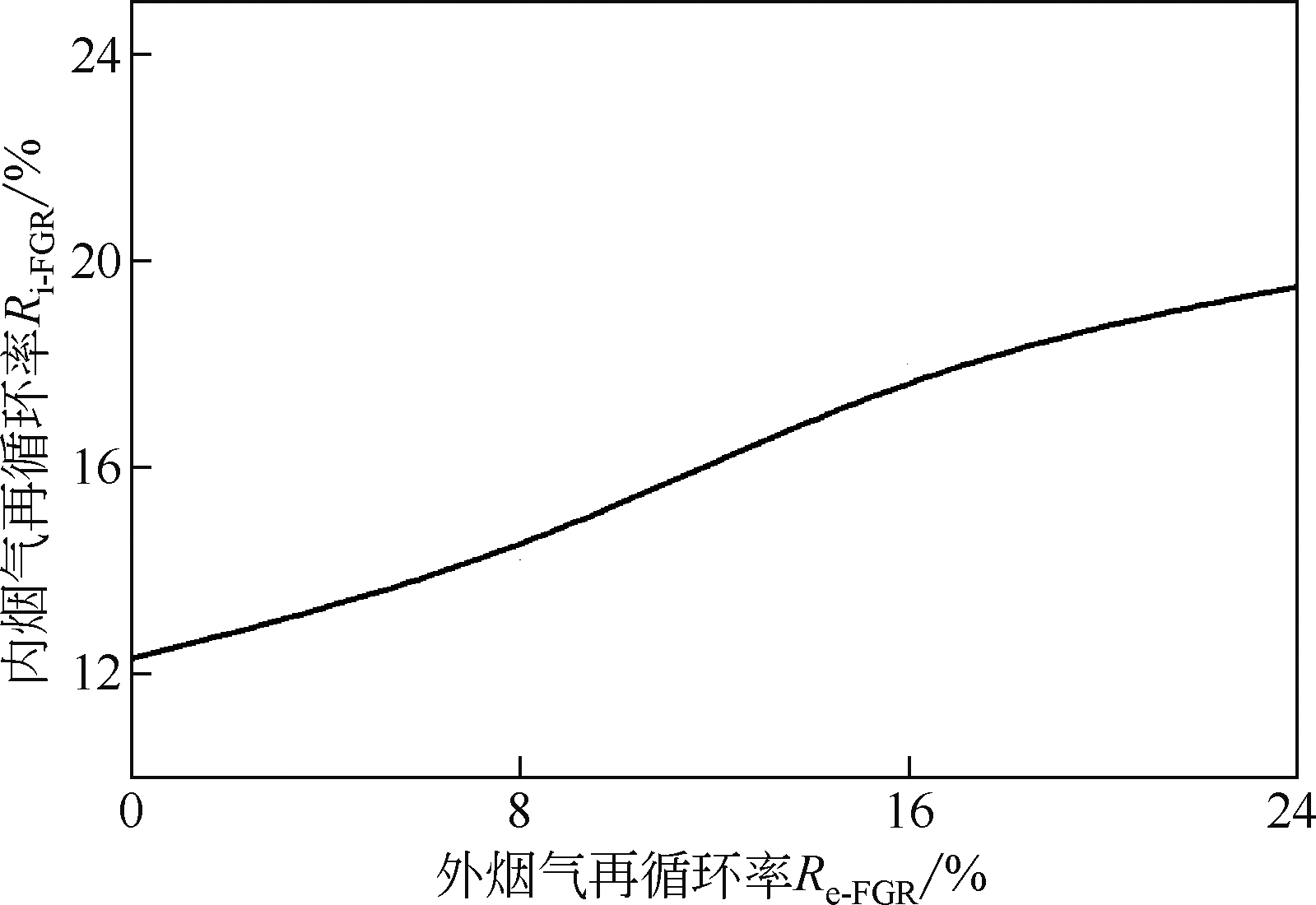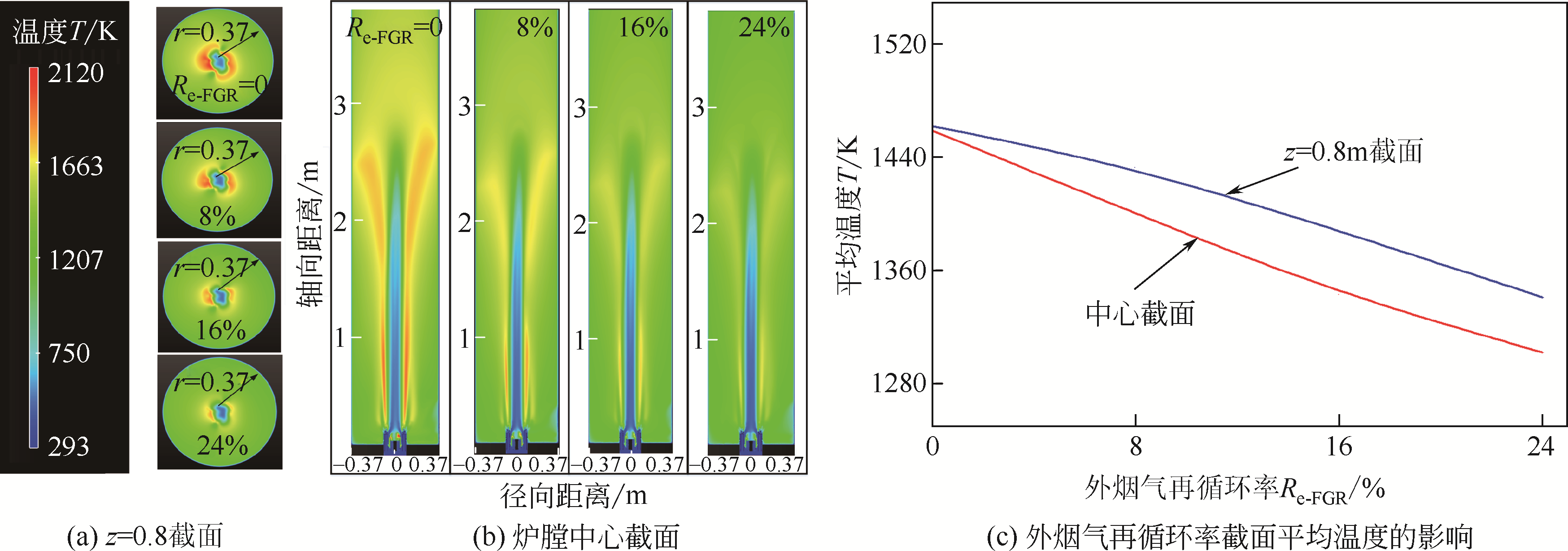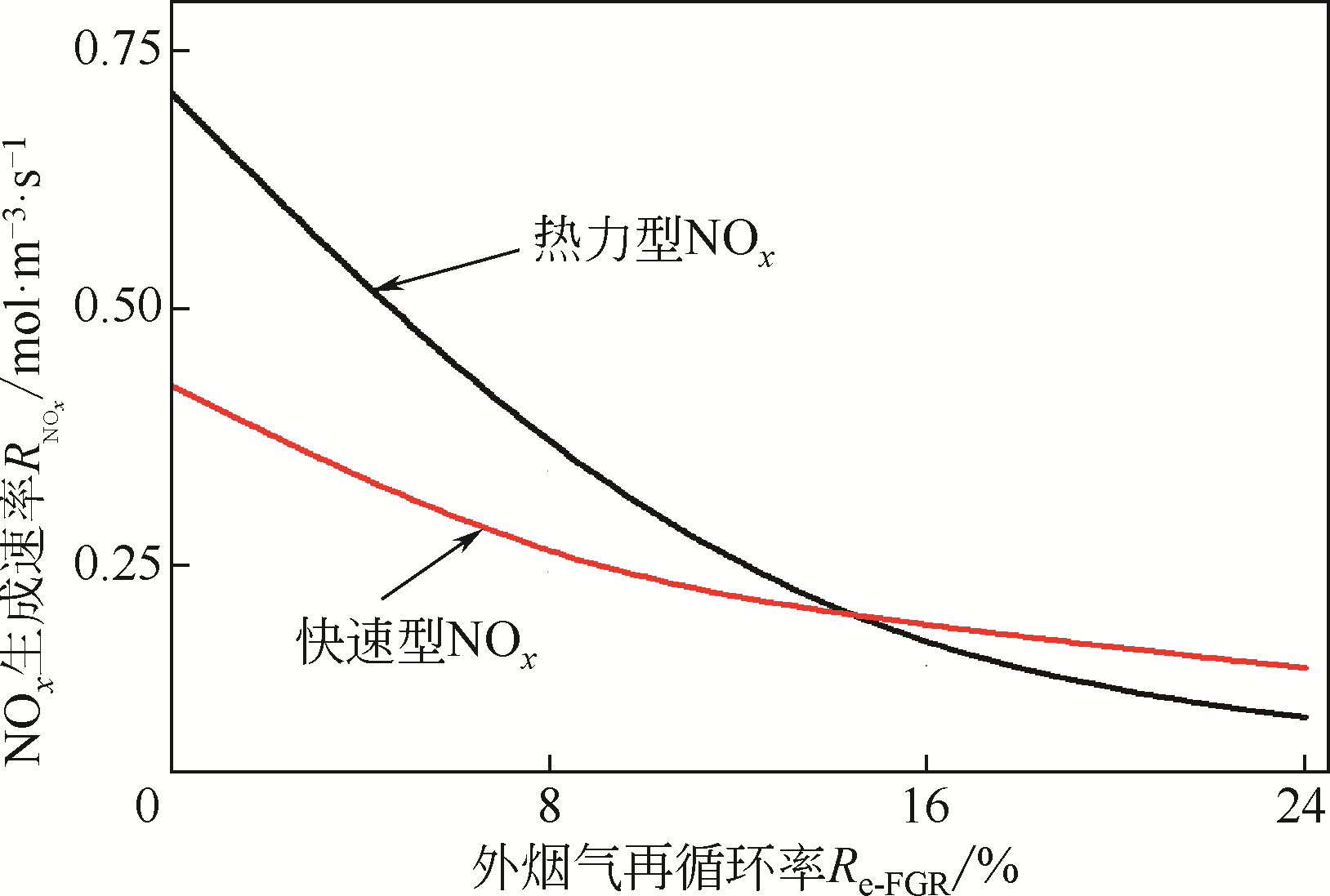Chemical Industry and Engineering Progress ›› 2019, Vol. 38 ›› Issue (9): 4327-4334.DOI: 10.16085/j.issn.1000-6613.2018-2321
• Resources and environmental engineering • Previous Articles Next Articles
I-/e-FGR effect on NOx emission of natural gas combustion
Zhining WANG1,2( ),Xiehe YANG2,Yang ZHANG1,2(
),Xiehe YANG2,Yang ZHANG1,2( ),Yan JIN1,2,Hai ZHANG1,2,Junfu LÜ2
),Yan JIN1,2,Hai ZHANG1,2,Junfu LÜ2
- 1. College of Electrical and Power Engineering, Taiyuan University of Technology, Taiyuan 030024, Shanxi, China
2. Key Laboratory for Thermal Science and Power Engineering of Ministry of Education, Department of Energy and Power Engineering, Tsinghua University, Beijing 100084, China
-
Received:2018-11-28Online:2019-09-05Published:2019-09-05 -
Contact:Yang ZHANG
内/外烟气再循环对天然气燃烧NOx生成的影响
王志宁1,2( ),杨协和2,张扬1,2(
),杨协和2,张扬1,2( ),金燕1,2,张海1,2,吕俊复2
),金燕1,2,张海1,2,吕俊复2
- 1. 太原理工大学电气与动力工程学院,山西 太原 030024
2. 清华大学能源与动力工程系热科学与动力工程;教育部重点实验室,北京 100084
-
通讯作者:张扬 -
作者简介:王志宁(1990—),男,硕士研究生,研究方向为天然气燃烧及污染物控制。E-mail:13485485840@163.com 。 -
基金资助:国家自然科学基金(51706119)
CLC Number:
Cite this article
Zhining WANG,Xiehe YANG,Yang ZHANG,Yan JIN,Hai ZHANG,Junfu LÜ. I-/e-FGR effect on NOx emission of natural gas combustion[J]. Chemical Industry and Engineering Progress, 2019, 38(9): 4327-4334.
王志宁,杨协和,张扬,金燕,张海,吕俊复. 内/外烟气再循环对天然气燃烧NOx生成的影响[J]. 化工进展, 2019, 38(9): 4327-4334.
share this article
Add to citation manager EndNote|Ris|BibTeX
URL: https://hgjz.cip.com.cn/EN/10.16085/j.issn.1000-6613.2018-2321
| 1 | 中国环境科学研究院. 火电厂大气污染物排放标准: GB 13223—2011[S]. 北京: 中国环境科学出版社, 2012. |
| Chinese Research Academy of Environmental Science. Thermal power plant air pollutant emission standards: GB 13223—2011[S]. Beijing: China Environmental Science Press, 2012. | |
| 2 | 北京市环境保护局. 锅炉大气污染物排放标准: DB11/ 139—2015 [S]. 北京: 北京市环境保护局, 2015. |
| Beijing Environmental Protection Bureau. Emission standard of air pollutants for boilers: DB11/139—2015[S]. Beijing: Beijing Environmental Protection Bureau, 2015. | |
| 3 | 宋少鹏, 卓建坤, 李娜, 等. 天然气供热锅炉低氮燃烧技术研究现状[J]. 供热制冷, 2016(2): 18-21. |
| SONGShaopeng, ZHUOJiankun, LINa, et al. Research status of low nitrogen combustion technology for natural gas heating boiler[J]. Heating and Cooling, 2016(2): 18-21 | |
| 4 | 胡元, 罗永浩, 周力行, 等. 外二次旋流风对旋流煤粉燃烧及NO生成的影响[J]. 化工学报, 2010, 61(9): 2437-2441. |
| HUYuan, LUOYonghao, ZHOULixing, et al. Effect of outer secondary air on swirling pulverized-coal combustion and NO formation[J]. CIESC Journal, 2010, 61(9): 2437-2441. | |
| 5 | SURJOSATYOA, PRIAMBODHOY D, KWOKC K. Investigation of gas swirl burner characteristic on biomass gasification system using combustion unit equipment (CUE)[J]. Journal Mekanikal, 2011, 33(12): 15-31. |
| 6 | HOUS S, LEE C Y, LINT H. Efficiency and emissions of a new domestic gas burner with a swirling flame[J]. Energy Conversion and Management, 2007, 48(5): 1401-1410. |
| 7 | 刘慧, 张林, 杨晓晰, 等. 缝式低NOx燃烧器结构的优化模拟[J]. 化工学报, 2018, 69(4): 1723-1730. |
| LIUHui, ZHANGLin, YANGXiaoxi, et al. Structure optimization simulation of slit burner with low NOx[J]. CIESC Journal, 2018, 69(4): 1723-1730. | |
| 8 | 岑可法, 姚强. 高等燃烧学[M]. 杭州: 浙江大学出版社, 2002: 603-610. |
| CENKefa, YAOQiang. Advanced combustion[M]. Hangzhou: Zhejiang University Press, 2002: 603-610. | |
| 9 | 吴晓磊, 刘波, 任政, 等. 新型低氮燃气分级燃烧器燃烧特性和NOx排放的CFD研究[J]. 化工进展, 2014, 33(9): 2298-2303. |
| WUXiaolei, LIUBo, RENZheng, et al. CFD study on combustion properties and NOx emission of reboiling furnace for xylene tower[J]. Chemical Industry and Engineering Progress, 2014, 33(9): 2298-2303. | |
| 10 | BAIWengang, LIHao, DENGLei, et al. Air-staged combustion characteristics of pulverized coal under high temperature and strong reducing atmosphere conditions[J]. Energy & Fuels, 2014, 28(3): 1820-1828. |
| 11 | 宋少鹏, 卓建坤, 李娜, 等. 燃料分级与烟气再循环对天然气低氮燃烧特性影响机理[J]. 中国电机工程学报, 2016, 36(24): 6849-6858. |
| SONGShaopeng, ZHUOJiankun, LINa, et al. Low NOx combustion mechanism of a natural gas burner with fuel-staged and flue gas recirculation[J]. Journal of Chinese Electrical Engineering Science, 2016, 36(24): 6849-6858. | |
| 12 | 刘皓, 任瑞琪, 黄永俊, 等. 富氧燃烧系统中NO的还原及其排放[J]. 化工学报, 2011, 62(2): 495-501. |
| LIUHao, RENRuiqi, HUANGYongjun, et al. Reduction and emission of NO in oxy-fuel system[J]. CIESC Journal, 2011, 62(2): 495-501. | |
| 13 | LEE C Y, BAEKS W. Effects of hybrid reburning/SNCR strategy on NOx/CO reduction and thermal characteristics in oxygen-enriched LPG flame[J]. Combustion Science and Technology, 2007, 179(8): 1649-1666. |
| 14 | AUDAIH A, JAMALN, DAVIDD. CFD modelling of air-fired and oxy-fuel combustion in a large-scale furnace at Loy Yang A brown coal power station[J]. Fuel, 2012, 102: 646-665. |
| 15 | 曾强, 刘汉周, 阎良. 烟气再循环对天然气非预混燃烧NOx排放特性的影响[J]. 燃烧科学与技术, 2018, 24(4): 369-375. |
| ZENGQiang, LIUHanzhou, YANLiang. Effect of flue gas recirculation on NOx emission characteristics of natural gas non-premixed combustion[J]. Journal of Combustion Science and Technology, 2018, 24(4): 369-375. | |
| 16 | 江子箫, 陈晓平, 蒋志坚, 等. 城市污泥流化床燃烧过程中气态污染物排放特性[J]. 化工进展, 2018, 37(1): 368-374. |
| JIANGZixiao, CHENXiaoping, JIANGZhijian, et al. Gaseous pollutants emissions from fluidized bed combustion of municipal sewage sludge[J]. Chemical Industry and Engineering Progress, 2018, 37(1): 368-374. | |
| 17 | 张利琴, 宋蔷, 吴宁, 等. 煤烟气再循环富氧燃烧污染物排放特性研究[J]. 中国电机工程学报, 2009, 29(29): 35-40. |
| ZHANGLiqin, SONGQiang, WUNing, et al. Study on pollutant emission characteristics from oxy-fuel combustion of coal with recycled flue gas[J]. Proceedings of the CSEE, 2009, 29(29): 35-40 | |
| 18 | HO E S, CHUNGS H. Numerical evaluation of NOx, mechanisms in methane-air counter flow premixed flames[J]. Journal of Mechanical Science & Technology, 2009, 23(3): 659-666. |
| 19 | BALTASARJ, CARVALHOM G, COELHOP, et al. Flue gas recirculation in a gas-fired laboratory furnace: measurements and modelling[J]. Fuel, 1997, 76(10): 919-929. |
| 20 | CHO E S, CHUNGS H. Characteristics of NOx emission with flue gas dilution in air and fuel sides[J]. KSME International Journal, 2004, 18(12): 2303-2309. |
| 21 | 徐旭常, 吕俊复, 张海. 燃烧理论与燃烧设备[M]. 北京: 机械工业出版社, 1990. |
| XUXuchang, JunfuLÜ, ZHANGHai. Combustion theory and combustion equipment[M]. Beijing: China Machine Press, 1990. | |
| 22 | MILLERJ A, BOWMANC T. Erratum: mechanism and modeling of nitrogen chemistry in combustion[J]. Progress in Energy & Combustion Science, 1990, 16(4): 287-338. |
| 23 | 王海峰, 陈义良. 湍流扩散火焰中氮氧化物排放的数值研究[J]. 化工学报, 2005, 56(2): 209-214. |
| WANGHaifeng, CHENYiliang. Numerical investigation of nitrogen oxides emission from turbulent non-premixed flames[J]. Journal of Chemical Engineering and Industry (China), 2005, 56(2): 209-214. | |
| 24 | 谢正武, 梁海杰. 烟气再循环的作用及其对锅炉热力计算的影响[J]. 能源研究与信息, 1999, 15(3): 42-48. |
| XIEZhengwu, LIANGHaijie. The function of the gas recirculation of boilers and its effect on thermal calculation[J]. Energy Research and Information, 1999, 15(3): 42-48. | |
| 25 | 胡满银, 乔欢, 杜欣, 等. 烟气再循环对炉内氮氧化物生成影响的数值模拟[J]. 华北电力大学学报(自然科学版), 2007, 34(6): 77-82. |
| HUManyin, QIAOHuan, DUXin, et al. Numerical simulations of the influence of flue gas recycle on nitrogen oxide formation in boiler[J]. Journal of North China Electric Power University, 2007, 34(6): 77-82. | |
| 26 | FEESEJ J, TURNSS R. Nitric oxide emissions from laminar diffusion flames: effects of air-side versus fuel-side diluent addition[J]. Combustion & Flame, 1998, 113(1/2): 66-78. |
| 27 | LIPARDIA C A, BERGTHORSONJ M, BOURQUEG. NOx emissions modeling and uncertainty from exhaust-gas-diluted flames[J]. Journal of Engineering for Gas Turbines & Power, 2015, 138(5): 051506. |
| 28 | DRISCOLLJ F, CHENR H, YOONY. Nitric oxide levels of turbulent jet diffusion flames: effects of residence time and Damköhler number [J]. Combustion & Flame, 1992, 88(1): 37-49. |
| 29 | 李新宇. 天然气非催化部分氧化转化炉内燃烧特性研究[D]. 上海: 华东理工大学, 2017. |
| LIXinyu. Study of the combustion characteristics in natural gas non-catalytic partial oxidation reformer[D]. Shanghai: East China University of Science and Technology, 2017. |
| [1] | WANG Tai, SU Shuo, LI Shengrui, MA Xiaolong, LIU Chuntao. Dynamic behavior of single bubble attached to the solid wall in the AC electric field [J]. Chemical Industry and Engineering Progress, 2023, 42(S1): 133-141. |
| [2] | CHEN Kuangyin, LI Ruilan, TONG Yang, SHEN Jianhua. Structure design of gas diffusion layer in proton exchange membrane fuel cell [J]. Chemical Industry and Engineering Progress, 2023, 42(S1): 246-259. |
| [3] | YANG Yudi, LI Wentao, QIAN Yongkang, HUI Junhong. Analysis of influencing factors of natural gas turbulent diffusion flame length in industrial combustion chamber [J]. Chemical Industry and Engineering Progress, 2023, 42(S1): 267-275. |
| [4] | ZHAO Wei, ZHAO Deyin, LI Shihan, LIU Hongda, SUN Jin, GUO Yanqiu. Synthesis and application of triazine drag reducing agent for nature gas pipeline [J]. Chemical Industry and Engineering Progress, 2023, 42(S1): 391-399. |
| [5] | WANG Ying, HAN Yunping, LI Lin, LI Yanbo, LI Huili, YAN Changren, LI Caixia. Research status and future prospects of the emission characteristics of virus aerosols in urban wastewater treatment plants [J]. Chemical Industry and Engineering Progress, 2023, 42(S1): 439-446. |
| [6] | GUO Qiang, ZHAO Wenkai, XIAO Yonghou. Numerical simulation of enhancing fluid perturbation to improve separation of dimethyl sulfide/nitrogen via pressure swing adsorption [J]. Chemical Industry and Engineering Progress, 2023, 42(S1): 64-72. |
| [7] | LI Ning, LI Jinke, DONG Jinshan. Research and development of porous medium burner in ethylene cracking furnace [J]. Chemical Industry and Engineering Progress, 2023, 42(S1): 73-83. |
| [8] | SHAO Boshi, TAN Hongbo. Simulation on the enhancement of cryogenic removal of volatile organic compounds by sawtooth plate [J]. Chemical Industry and Engineering Progress, 2023, 42(S1): 84-93. |
| [9] | CHEN Lin, XU Peiyuan, ZHANG Xiaohui, CHEN Jie, XU Zhenjun, CHEN Jiaxiang, MI Xiaoguang, FENG Yongchang, MEI Deqing. Investigation on the LNG mixed refrigerant flow and heat transfer characteristics in coil-wounded heat exchanger (CWHE) system [J]. Chemical Industry and Engineering Progress, 2023, 42(9): 4496-4503. |
| [10] | LIU Xuanlin, WANG Yikai, DAI Suzhou, YIN Yonggao. Analysis and optimization of decomposition reactor based on ammonium carbamate in heat pump [J]. Chemical Industry and Engineering Progress, 2023, 42(9): 4522-4530. |
| [11] | ZHAO Xi, MA Haoran, LI Ping, HUANG Ailing. Simulation analysis and optimization design of mixing performance of staggered impact micromixer [J]. Chemical Industry and Engineering Progress, 2023, 42(9): 4559-4572. |
| [12] | XU Jie, XIA Longbo, LUO Ping, ZOU Dong, ZHONG Zhaoxiang. Progress in preparation and application of omniphobic membranes for membrane distillation process [J]. Chemical Industry and Engineering Progress, 2023, 42(8): 3943-3955. |
| [13] | YE Zhendong, LIU Han, LYU Jing, ZHANG Yaning, LIU Hongzhi. Optimization of thermochemical energy storage reactor based on calcium and magnesium binary salt hydrates [J]. Chemical Industry and Engineering Progress, 2023, 42(8): 4307-4314. |
| [14] | YU Junnan, YU Jianfeng, CHENG Yang, QI Yibo, HUA Chunjian, JIANG Yi. Performance prediction of variable-width microfluidic concentration gradient chips by deep learning [J]. Chemical Industry and Engineering Progress, 2023, 42(7): 3383-3393. |
| [15] | SHAN Xueying, ZHANG Meng, ZHANG Jiafu, LI Lingyu, SONG Yan, LI Jinchun. Numerical simulation of combustion of flame retardant epoxy resin [J]. Chemical Industry and Engineering Progress, 2023, 42(7): 3413-3419. |
| Viewed | ||||||
|
Full text |
|
|||||
|
Abstract |
|
|||||

